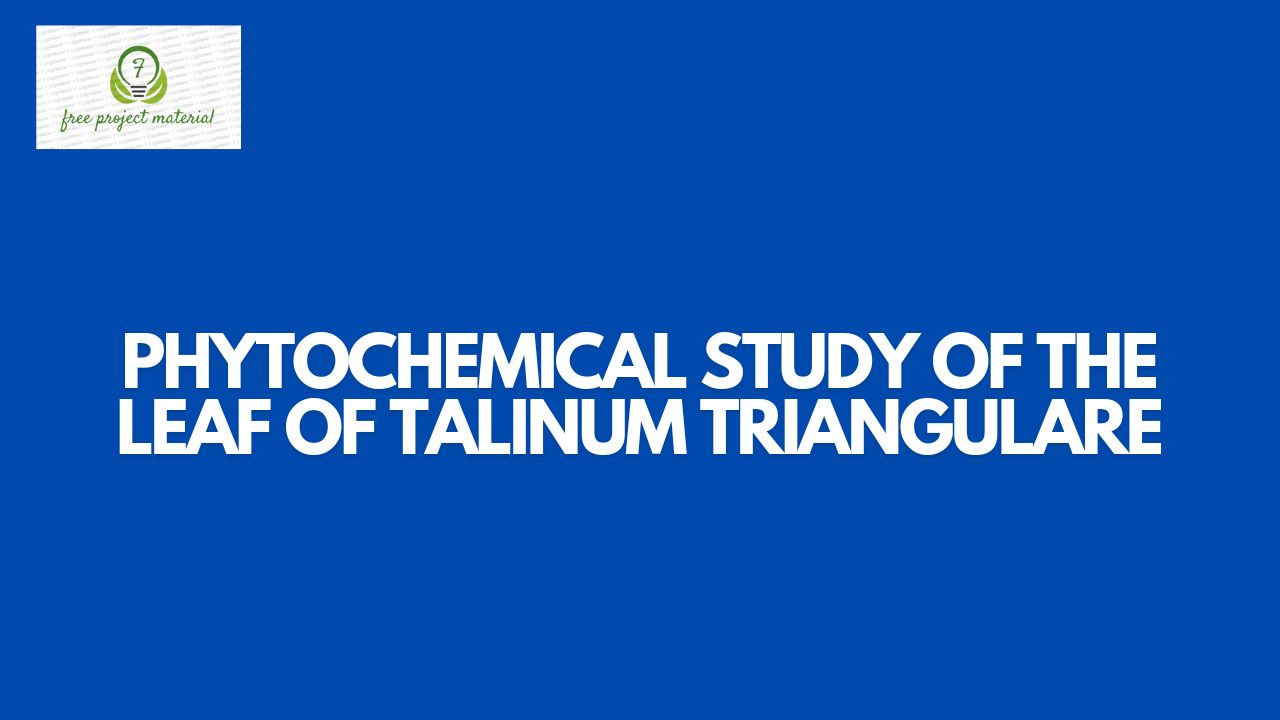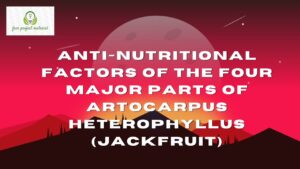ABSTRACT
Phytochemical study of the leaf of Talinum triangulare were carried out using standard analytical method. The results revealed that Alkaloid and Tannin were presence at moderate concentration. Flavonoids, Cardiac glycoside and Terpene were in Trace concentration and saponin was Much concentration. Hence, the leaf of Talinum triangulare can be used medicinally in the treatment of illnesses.
TABLE OF CONTENTS
Title Page- – – – – – – – – i
Certification- – – – – – – – ii
Dedication – – – – – – – – – iii
Acknowledgments- – – – – – – iv
Abstract- – – – – – – – – v
Table of Contents- – – – – – – – vi-viii
CHAPTER ONE: INTRODUCTION
1.1 Background of the Study- – – – – – 1-4
1.2 Aim and Objectives of the Study- – – – – 5
1.3 Scope and Limitation of the Study- – – – – 5
CHAPTER TWO: LITERATURE REVIEW
2.1 Botanical Classification of Talinum triangulare– – – 6-7
2.2 Description of Talinum triangulare– – – – – 7-8
2.3 Nutritional Values of Talinum triangulare– – – – 8-9
2.4 Proximate and Mineral Composition
of Talinum triangulare– – – – – – – 9-11
2.5 Health Benefit of Talinum triangulare– – – – 11-14
2.6 Phytochemicals – – – – – – – – 14
2.6.1 Flavonoids- – – – – – – – – 14-16
2.6.2 Phenolic Acids- – – – – – – – 16-19
2.6.3 Tannins- – – – – – – – – 19-20
2.6.4 Alkaloids- – – – – – – – – 20-22
2.6.5 Saponins- – – – – – – – – 22-23
2.6.6 Cardiac Glycosides- – – – – – – 24-25
2.6.7 Terpene- – – – – – – – – 26
CHAPTER THREE: MATERIALS AND METHODS.
3.1 Materials- – – – – – – – – 27
3.2 Method of Phytochemical Analysis – – – – – -27
3.21 Sample Collection and Preparation – – – – – 27-28
3.2.2 Determination of phytochemical composition
of Talinum Triangulare– – – – – – – 28-30
CHAPTER FOUR: RESULTS AND DISCUSSION
4.1 Results- – – – – – – – – 31-32
4.2 Discussion- – – – – – – – – 33-34
CHAPTER FIVE: CONCLUSION AND RECOMMENDATION
5.1 Conclusion- – – – – – – – – 35
5.2 Recommendations- – – – – – – 35
References
CHAPTER ONE: INTRODUCTION
1.1 Background of the Study
Vegetables serve as indispensable constituents of the human diet supplying the body with minerals, vitamins and certain hormone precursors, in addition to protein and energy (Oyenuga and Fetuga, 1975). Several vegetable species abound in Nigeria and most West African countries where they are used partly as condiments or spices in human diets or as supplementary feeds to livestock such as rabbits, poultry, swine and cattle. These vegetables are harvested at all stages of growth and fed either as processed, semi-processed or fresh to man while they are usually offered fresh to livestock. Leafy vegetables are known to add taste and flavour, as well as substantial amount of proteins, fibre, minerals and vitamins to the diet.
While the amounts of the nutrient constituents in the more commonly used leaf vegetable species in Nigeria have been studied to some extent, the lesser known regional and local species remain virtually neglected. Lack of information on the specific nutrients and phytochemicals in a large number of the native vegetables species with which Nigeria is richly endowed is partly responsible for their under exploitation especially in areas beyond the traditional localities where they are found and consumed. Among the leafy vegetables in which their phytochemicals and nutrients have not been extensively studies are leaves of water leaf. Talinum triangulare (water leaf) is an herbaceous perennial, caules cent and glabrous plant widely grown in tropical regions as a leaf vegetable (Ezekwe et al., 2001).
It is consumed as a vegetable and constituent of a sauce in Nigeria. Nutritionally, water leaf has been shown to possess the essential nutrients like Bcarotene, minerals (such as calcium, potassium and magnesium), pectin, protein and vitamins (Ezekwe et al., 2001). Water leaf has been also implicated medically in the management of cardiovascular diseases like stroke, obesity, etc. (Adewunmi and Sofowora, 1980) and traditionally it is used as softener of other vegetable species.
Talinum triangulare (Jacq) Wild commonly called waterleaf is a vegetable and belongs to the family Portulacaceae. It is an erect succulent herb which can be found as a natural weed and sometimes cultivated as a short-lived perennial herb.
The plant is found in West Africa, West Indies, South America and in warmer parts of the world (Mabberly, 1980). In Nigeria, its wide acceptance across various ethnic groups has earned it several local names such as “ngbolodi” (Igbo), “mmon-mmong ikong” (Efik/Ibibio) and as “egure” (Yoruba) among others. The plant is cultivated during rainy season usually in a variety of habitats including road sides, open fields and abandoned agricultural lands (Edet and Sunday, 2007).
Vegetables vary considerably in their nutrient composition. Their carbohydrate content is low when compared with the starchy foods which form the bulk of the food eaten by man. They contain vitamins, essential amino acids, minerals and antioxidants. According to Okafor (1983), vegetables are the cheapest and most available source of proteins, vitamins, minerals and essential amino acids. Some of the important vegetables grown in Nigeria include Amaranthus cruentus L., Telfaria occidentalis Hook. F., Gongronema latifolium Benth, Celosia argentea L., Vernonia amygdalina Del., and Talinum triangulare (Jacq) Wild.
Nutritionally, both the leaves and tender stems of T. triangulare are consumed as part of dietary supplement in starchy foods, sauces, condiments, spices and flavourings in human diet. They are also used as supplementary feeds to livestock such as rabbits, poultry, swine and cattle. The nutrient contents of the leaves of T. triangulare as reported by Mensah et al (2008) include carbohydrate, protein, ash, lipids, amino acids, moisture, crude fiber, ascorbic acid, pectin, potassium, calcium, magnesium, iron, sodium, beta-carotene and vitamins. Mensah et al. (2008) showed that the leaves or roots of T. triangulare are either employed singly or in combination with other medicinal herbs as diuretics in gastrointestinal disorder. The leaves are also used in the treatment of ailments such as oedema, dropsy, swellings and scabies. The use of the roots in preparing rat poison has been reported by Aiyeloja and Bello (2005).
1.2 Aim and Objectives of the Study
The aim of this study is to investigate phytochemical contents of the leaf of Talinum triangulare.
Objectives of the Study
- To determine flavonoid and alkaloid contents in the leaf of Talinum triangulare.
- To determine tannins and terpene level in the leaf of Talinum triangulare.
- To determine saponin and cardiac glycoside level in the leaf of Talinum triangulare.
1.3 Scope and Limitation of the Study
The focused of the study is to investigate the determination of phytochemicals in the leaf of Talinum triangulare due to time and financial constraints as limitation.



